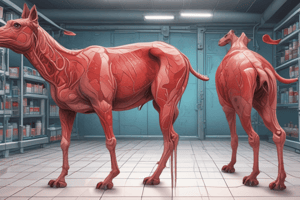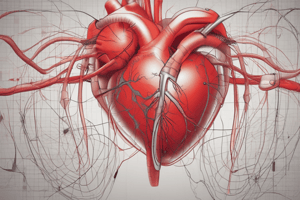Podcast
Questions and Answers
What does the perfusion triangle consist of?
What does the perfusion triangle consist of?
- Pipes = nervous system
- Pump = lungs
- Contents = blood (correct)
- Pump = heart (correct)
What happens when there is damage to the heart?
What happens when there is damage to the heart?
It cannot move enough blood through the body to support perfusion.
What is the result of blood/plasma loss?
What is the result of blood/plasma loss?
Not enough fluid to support perfusion needs of the body.
What occurs during rapid vessel dilation?
What occurs during rapid vessel dilation?
What does blood pressure indicate?
What does blood pressure indicate?
What conditions lead to blood clots forming?
What conditions lead to blood clots forming?
What is the pulse pressure in patients with shock?
What is the pulse pressure in patients with shock?
What regulates blood flow through capillary beds?
What regulates blood flow through capillary beds?
What are the basic causes of shock?
What are the basic causes of shock?
What are the types of pump failure?
What are the types of pump failure?
What types of poor vessel function exist?
What types of poor vessel function exist?
What are the types of low fluid volume?
What are the types of low fluid volume?
What is cardiogenic shock?
What is cardiogenic shock?
What is obstructive shock?
What is obstructive shock?
What is tension pneumothorax?
What is tension pneumothorax?
What happens during cardiac tamponade?
What happens during cardiac tamponade?
What is pulmonary embolism?
What is pulmonary embolism?
What is distributive shock?
What is distributive shock?
What causes septic shock?
What causes septic shock?
What is neurogenic shock?
What is neurogenic shock?
What causes anaphylactic shock?
What causes anaphylactic shock?
What happens during psychogenic shock?
What happens during psychogenic shock?
What is hypovolemic shock?
What is hypovolemic shock?
What is pericardial effusion?
What is pericardial effusion?
Flashcards are hidden until you start studying
Study Notes
Shock Overview
- Perfusion Triangle consists of heart (pump), blood vessels (pipes), and blood (contents) crucial for maintaining effective circulation.
- Damage to the Heart results in inadequate blood movement, compromising perfusion.
- Blood/Plasma Loss leads to insufficient fluid for body perfusion needs.
- Rapid Vessel Dilation occurs when blood volume is insufficient to fill vessels, hindering perfusion.
- Blood Pressure is an important indicator of perfusion status, providing a rough measure of blood flow adequacy.
Blood Clotting and Shock
- Blood Clots Formation is influenced by blood retention due to blockage, vessel wall changes, and the blood's clotting ability.
- Pulse Pressure in shock patients is generally less than 25 mm Hg, indicative of compromised circulation.
Regulation of Blood Flow
- Capillary Sphincters regulate blood flow through capillaries and are controlled by the autonomic nervous system, impacting tissue perfusion.
Basic Causes of Shock
- Three Main Causes:
- Pump failure (cardiogenic shock)
- Poor vessel function (distributive shock)
- Low fluid volume (hypovolemic shock)
Types of Shock
-
Pump Failure Types:
- Cardiogenic Shock: Inadequate heart function causes blood to back up into the lungs.
- Obstructive Shock: Mechanical obstruction impedes blood filling in heart chambers, including:
- Tension pneumothorax (air in the chest cavity)
- Cardiac tamponade (blood in pericardial sac)
- Pulmonary embolism (blood clot in pulmonary artery)
-
Poor Vessel Function Types:
- Distributive Shock: Characterized by widespread dilatation of small arterioles and venules, includes:
- Septic Shock: Severe bacterial infections release toxins damaging vessel walls.
- Neurogenic Shock: Caused by high spinal cord injury leading to loss of sympathetic nerve function and muscle contraction in blood vessels.
- Anaphylactic Shock: Severe allergic reactions to substances such as stings, injections, ingestion, or inhalation.
- Psychogenic Shock: Temporary vascular dilation resulting in fainting, with blood pooling and reducing brain blood supply.
- Distributive Shock: Characterized by widespread dilatation of small arterioles and venules, includes:
-
Low Fluid Volume Types:
- Hypovolemic Shock: Results from inadequate fluid volume, can be hemorrhagic or non-hemorrhagic.
Additional Shock-Related Conditions
- Pericardial Effusion: Fluid collects between the pericardial sac and myocardium, potentially leading to cardiac tamponade by preventing adequate ventricular filling.
Studying That Suits You
Use AI to generate personalized quizzes and flashcards to suit your learning preferences.




